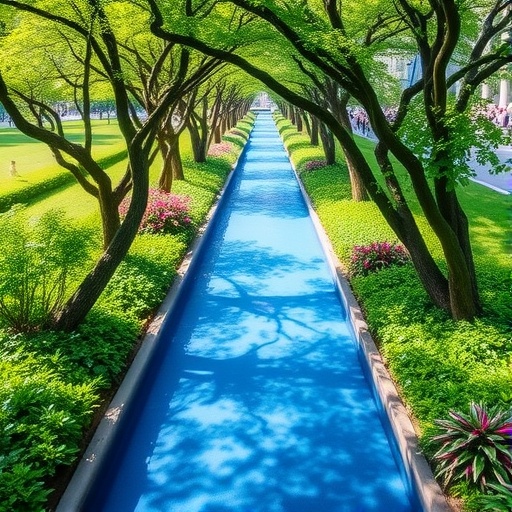In an era marked by rapid urbanization and climate change, cities around the globe are grappling with the increasing problem of rising temperatures. As concrete jungles expand, the consequences of urban heat islands—regions that experience significantly higher temperatures than their rural counterparts—are becoming more pronounced. This phenomenon not only contributes to discomfort for residents but also heightens health risks and energy consumption. Against this backdrop, a recent study by Hsu, Sathianarayanan, and Gianoli provides crucial insights into how urban green and blue spaces in Taipei can be optimized to mitigate these warming effects.
The research underscores the significance of incorporating greenery and water bodies into urban planning. Trees, parks, green roofs, and waterways are not merely aesthetic additions to cityscapes; they serve as vital components of urban infrastructure that regulate temperatures. The authors emphasize that strategically placed green and blue spaces can significantly alleviate the heat generated by urban development. The findings suggest a proactive approach to holistic city planning that prioritizes ecological balance alongside urban growth.
As temperatures continue to rise, the cooling effects of urban vegetation become an essential consideration for municipal authorities. The study highlights the cooling benefits associated with urban forestry, where trees serve as natural air conditioners. Through processes such as evapotranspiration, trees absorb sunlight and release moisture into the air, thereby reducing surrounding temperatures. This natural mechanism offers a sustainable alternative to energy-intensive cooling systems prevalent in many cities today.
Moreover, the authors make a compelling argument for integrating water features into urban environments. Lakes, rivers, and fountains not only enhance aesthetic appeal but also contribute significantly to temperature regulation. The presence of water bodies promotes evaporation, which can lead to localized cooling effects that counteract the heat produced by urban infrastructure. As cities implement more comprehensive water management strategies, the dual benefits of flood prevention and temperature moderation come to the forefront of urban resilience planning.
The significance of the study extends beyond mere academic curiosity; it holds profound implications for public health. Increased urban temperatures are linked to a rise in heat-related health issues, including heat exhaustion and heat strokes, particularly among vulnerable populations such as the elderly and young children. By strategically enhancing green and blue spaces, city planners can help mitigate these health risks, ensuring a healthier living environment for all residents.
Despite the clear benefits, the implementation of such initiatives presents its own set of challenges. Limited urban space, financial constraints, and competing land-use priorities often impede efforts to create more green and blue areas in cities. The study advocates for innovative solutions that can overcome these hurdles, such as vertical gardens, green walls, and multifunctional parks that serve various community needs while also providing cooling benefits.
The researchers also explore the socio-economic dimensions of urban greening. Access to green spaces is often unevenly distributed, with marginalized communities frequently bearing the brunt of heat stress due to the lack of proximity to parks and natural areas. The study stresses that urban planning must take into account social equity to ensure that all citizens can enjoy the cooling and health benefits associated with green and blue spaces. By fostering inclusivity in urban design, cities can create environments that support physical and mental well-being for a diverse population.
Adopting a multidisciplinary approach is vital to the successful integration of urban green and blue spaces. Collaboration between urban planners, ecologists, architects, and stakeholders is essential in designing spaces that are not only functional but also contribute to biodiversity. Engaging communities in the decision-making process further strengthens the bond between residents and their environment, fostering a sense of ownership over local green initiatives.
The ongoing effects of climate change necessitate immediate action. The study serves as a clarion call for urban planners and local governments to prioritize sustainable practices in city development. As global temperatures rise, innovative responses that harness the benefits of nature in urban settings become increasingly imperative. The research holds promise for the future of urban living, offering a roadmap to cooling cities through nature-based solutions.
In conclusion, Hsu, Sathianarayanan, and Gianoli’s research reveals a promising path forward for cities like Taipei. By maximizing the strategic implementation of urban green and blue spaces, metropolitan areas can combat rising temperatures while enhancing public health and social equity. The authors hope to inspire global movements towards sustainable urban practices that harness the benefits of nature as a crucial part of climate adaptation strategies. As cities continue to develop, the need for sustainable solutions has never been more urgent, reminding us of the indispensable role that nature plays in creating livable urban environments.
The findings of this study not only provide a scientific basis for future urban development but also resonate with the public’s growing demand for greener cities. As awareness of climate change and environmental degradation increases, city residents are calling for action. This research equips policymakers with the necessary insights to make informed decisions that prioritize the welfare of their constituents while simultaneously addressing climate challenges.
Subject of Research: Urban green and blue spaces in Taipei and their cooling benefits.
Article Title: Maximizing cooling benefits through urban green and blue spaces in Taipei city.
Article References: Hsu, PH., Sathianarayanan, M. & Gianoli, A. Maximizing cooling benefits through urban green and blue spaces in Taipei city. Discov Cities 2, 115 (2025). https://doi.org/10.1007/s44327-025-00158-z
Image Credits: AI Generated
DOI: https://doi.org/10.1007/s44327-025-00158-z
Keywords: Urban heat islands, urban planning, environmental sustainability, public health, climate change, urban forestry, green spaces, blue spaces, biodiversity, social equity.




